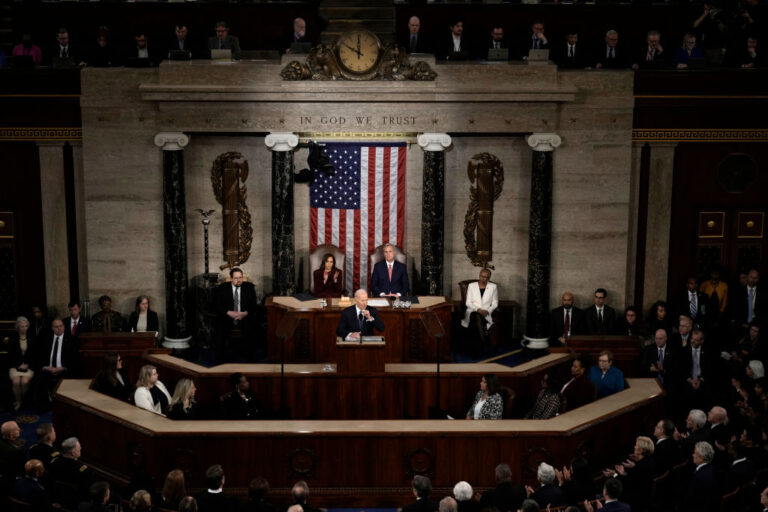State of the Modern Administrative State

The Constitution requires the president “from time to time” to “give to the Congress Information of the State of the Union.”
Today, the State of the Union address is a performative event. But as George Will likes to remind us, ’twas not always thus: President Thomas Jefferson gave his thoughts to Congress in writing—a salutary practice ended by President Woodrow Wilson, who had a habit of fixing things that weren’t broken.
Jefferson—author of the Declaration of Independence and fierce defender of limited government—and Wilson—whose impatience with the Constitution’s strictures helped normalize big-government-by-“experts”—serve as contrasting models for how the federal government should behave. Today, are we closer to Jefferson or Wilson?
Let’s forget the performative State of the Union. What the country needs every year is an honest update on the State of the Modern Administrative State.
Unfortunately, the Modern Administrative State remains strong, powerful, and in many cases lawless. Just as Wilson and his progressive friends intended, but contrary to the Constitution’s separation of powers, administrative agencies today “combine[]” legislative, executive, and judicial powers.
Specifically, today’s federal agencies
- exercise legislative power by adopting regulations that bind the public—often exceeding the plain text of statutes that define agencies’ authority;
- exercise executive power by prosecuting alleged violations of statutes and (their own) regulations; and
- exercise judicial power by adjudicating cases of alleged violations (of their own rules) that they themselves (in their executive capacity) initiate.
The Supreme Court, while struggling to fit these agencies in the Constitution’s structure, has too often blessed the administrative state’s growth despite its obvious tension with the Founders’ design. But in recent decades, the Court has again taken seriously the Constitution’s careful separation of powers, whose purpose, after all, is to “diffuse power the better to secure liberty.”
The great difficulty and the solution
Jefferson’s Declaration of Independence listed the Crown’s “repeated injuries and usurpations,” which intended “the establishment of an absolute Tyranny over these States.” Among other things, King George III:
- made Judges dependent on his Will alone, for the tenure of their offices, and the amount and payment of their salaries.
- erected a multitude of New Offices, and sent hither swarms of Officers to harass our people, and eat out their substance.
Because of these and many other injuries and usurpations, Jefferson and the other Founders broke with Britain. And the Framers later sought to prevent their recurrence with a new Constitution.
Not an easy task. Indeed, the Constitution’s principal author James Madison identified the “great difficulty” in “framing a government which is to be administered by men over men”—namely, that one “must first enable the government to control the governed; and in the next place oblige it to control itself.” But Madison also identified the best way to so oblige the government—by separating its powers among three co-equal branches.
The Constitution thus vests (1) “[a]ll legislative Powers herein granted” in Congress; (2) the “executive Power” in the President; and (3) the “judicial Power of the United States” in the judiciary. Congress writes the laws, the President executes the laws, and the judiciary resolves disputes about the application and meaning of the laws.
This framework protects the governed by obliging the government to control itself. In practice, all three branches must effectively assent to restrictions on the rights of life, liberty, and the pursuit of happiness. That is, the government may restrict someone’s rights only if the executive proves, to an independent judge (and jury), the violation of a law enacted by Congress.
The Constitution also includes provisions that address the two “injuries” of King George noted above. To prevent the executive from making judges dependent on his will alone for both tenure and salaries, the Constitution precludes the president from appointing judges without Senate approval. And the Constitution ensures that judges have lifetime appointments (during “good Behaviour”) and salaries that may not be reduced while in office.
And several parts of the Constitution aim to prevent the executive branch from unilaterally creating a multitude of offices and swarms of officers. First, through the “necessary and proper” clause and its power of the purse, Congress is tasked with creating offices and delimiting their mandate. And the president “shall”—is obligated to—“take Care that the Laws [enacted by Congress] be faithfully executed.” And, again, the president cannot appoint “officers of the United States” without Senate approval (unless Congress “by Law” provides otherwise for “inferior” officers). Through these provisions, offices and officers in the executive branch are accountable to the president, who is accountable to the people.
The great difficulty returns
Before he was elected president, Woodrow Wilson lamented that some of his fellow citizens “have never got beyond the Declaration of Independence.” He argued that the Constitution was fine for its era, but in modern times, the government must do “whatever experience permits or the times demand.” Fellow progressive Frank Goodnow agreed: “Social expediency, rather than natural right, is… to determine the sphere of individual freedom of action.”
With Goodnow and others, Wilson championed not the Constitution’s separation of powers, but the separation of partisan politics and “expert”—supposedly neutral—“administration.” Indeed, Wilson and his progressive friends believed the Constitution’s separation of powers was an anachronism that stood in the way of modern government. According to Professor Ronald Pestritto, it was Wilson (in 1885) who, “for the first time in the United States,” “explicitly” made “the case for separating politics and administration and for freeing administration from the confines of constitutional law.”
In short, the founders of the Modern Administrative State consciously endeavored to break from the Declaration of Independence and the restrictions imposed on government by the Constitution’s separation of powers. They intentionally established what they considered to be extra-constitutional “expert” agencies, which were entitled to (as modern defenders put it) “deferential oversight … so that the nation’s regulatory experiment could continue.”
This experiment has resulted in scores of regulatory agencies that do indeed enjoy freedoms from the confines of constitutional law and continue to expand their reach.
Today’s ‘vast and varied’ bureaucracy
As Chief Justice John Roberts observed in a 2013 dissent, the “Framers could hardly have envisioned today’s ‘vast and varied federal bureaucracy’ and the authority administrative agencies now hold over our economic, social, and political activities.” What’s more, he continued, “the federal bureaucracy continues to grow; in the last 15 years, Congress has launched more than 50 new agencies. … [M]ore are on the way.”
Thus, the government has erected a new multitude of offices that send out swarms of officers to harass the people and devastate their substance. And they do so by concentrating in themselves all three powers of government.
Officially, agencies are tasked with merely administering—carrying out—the laws written by Congress and, in that capacity, “filling in the details.” But in practice agencies adopt sweeping regulatory programs that have the force and effect of law. And this practice has been growing. In the 1940s, the Federal Register—the official daily publication for rules, proposed rules, various notices, and presidential executive orders—published around 100,000 pages; in this decade, that number is over 800,000 pages.
Most rules are adopted through a “notice-and-comment” procedure, whereby agencies announce a proposed rule, consider comments, and then issue “final” rules. Since 1993, agencies have issued almost 115,000 final rules. The number of agency rules dwarfs the number of actual laws enacted by Congress. For example, last year, the Biden administration issued 3,108 rules, while only 65 bills were signed into law. This has been a consistent trend.
But it gets worse. Although only “final” rules are officially binding on the public, agencies regularly publish non-final documents—“interpretive” rules, “guidances,” “Dear Colleague” letters, staff manuals, bulletins, advisories, etc.—that encourage compliance through the threat of compliance actions. For instance, guidance documents ostensibly provide nothing more than an agency’s “current thinking” on a given topic. But a private entity may later find that this mere “thinking” turns out to be the basis for enforcement and ruinous fines.
As an example, in one of PLF’s most important cases, the Ninth Circuit Court of Appeals relied on guidance—even appending it to its decision—to hold landowners liable under the Clean Water Act. By the time the Supreme Court reversed in 2023, the Sacketts had been engaged in a battle with the EPA for over 15 years.
Agencies may even adopt rules through in-house adjudications and apply those new rules retroactively—even though the conduct was perfectly legal at the time.
Nor are these adjudications fair to begin with.
Another PLF case serves as a good example. PLF’s client Leachco, Inc. is accused by the Consumer Product Safety Commission of selling a “substantial product hazard.” The CPSC commissioners voted 3-1 to initiate the case. Commission lawyers are prosecuting the case before an administrative law judge (ALJ), who is on loan to the CPSC from another federal agency. In this hearing, as in hearings across the federal government, the Federal Rules of Civil Procedure and Federal Rules of Evidence are merely default rules. For example, although hearsay evidence is generally excluded from trials in court, such evidence may be admitted in CPSC hearings at the ALJ’s discretion. Similarly, Leachco was denied the benefit of full discovery rules that are required in federal court. And Leachco is denied the right to a jury. If Leachco is unsuccessful before the ALJ—and, not surprisingly, most private parties do lose in agency adjudications—then it may appeal—to the CPSC commissioners who initiated the case in the first place. And on appeal, the commissioners may ignore the ALJ’s findings of fact and adopt their own. Only after this process may Leachco seek review in a court of law. But even here, full judicial review is precluded, as the judge must defer to the Commission’s findings of fact and in practice regularly defers to agency legal conclusions. Without PLF’s free representation, Leachco would almost certainly have been forced to capitulate long ago. Many small businesses do in fact surrender.
The separation of powers—again
But there is room for optimism. PLF recently launched a project to end these in-house adjudications that threaten the deprivation of the core private rights of life, liberty, and property. And the Supreme Court in the past few decades has begun to enforce the Constitution’s separation of powers against the excesses of the Modern Administrative State.
An important marker was PLF’s first litigation in Sackett v. EPA. There, the EPA and Army Corps of Engineers informed the Sacketts that their residential property, on which they wanted to build a house, contained wetlands. The Sacketts were ordered to stop everything and were threatened with fines of over $30,000 per day. The EPA refused to reconsider this decision and denied the Sacketts any kind of hearing. A unanimous Supreme Court held that the EPA was required to provide a hearing, after which the Sacketts were entitled to judicial review.
Two years earlier, the Supreme Court issued Free Enterprise Fund v. PCAOB, another case, like Sackett, in which the Court required accountability by administrative agencies. In Free Enterprise Fund, the Public Company Accounting Oversight Board was an entity within another entity, the Securities and Exchange Commission. Members of the Board—officers of the United States—could not be removed from office by the SEC except “for cause,” e.g., malfeasance in office. But SEC commissioners themselves could not be removed from office by the president except for cause. The Supreme Court held that this dual-layer for-cause protection was contrary to the president’s obligations to faithfully execute the laws, as the protection prevented the president from holding Board members accountable.
More recently, in 2018, the Supreme Court held that administrative law judges in the SEC are “officers of the United States,” subject to the strictures of the Appointments Clause, which as noted above requires Senate approval of presidential appointments (unless Congress has, “by Law” provided other means for the appointment of “inferior” officers). This decision, again, makes the president more accountable for the actions of executive-branch agencies.
In Kisor v. Wilkie, a 2019 decision, the Supreme Court significantly scaled back the deference that courts had given to agency interpretations of regulations. Courts had long given significant deference to the views of agencies. And while agencies may argue their positions, it is ultimately the courts that decide what the laws mean. In Kisor, the Court claimed to be merely restating its position. But in fact, the Court explicitly required courts to exhaust all the tools of interpretation and construction before they may consider deferring to agency interpretations.
In 2023, the Supreme Court held in Axon Enter., Inc. v. FTC that private parties subject to an “unconstitutionally structured” agency may sue in federal court to challenge the agency’s authority. By “unconstitutionally structured,” the Court referred to agencies whose officials sit in office contrary to the strictures of the Appointments Clause. And, generally, parties subject to an agency action had been required to go through the exhaustive administrative proceeding—like the one Leachco now suffers through—and raise constitutional challenges afterward. In Axon, the Court said that merely being subjected to an unconstitutionally structured agency was an injury that could be addressed immediately, before the administrative proceeding is completed.
Finally, the Supreme Court recently heard oral arguments in SEC v. Jarkesy, a case arising out of an administrative adjudication held in SEC’s in-house tribunal. Mr. Jarkesy challenged the SEC’s structure, but he also argued that the SEC’s proceeding denied him his Seventh Amendment right to a jury. It’s always risky to make predictions about what the Supreme Court will do, but it seems likely that the Court will rule in Mr. Jarkesy’s favor.
Onward
Much remains to be done. Agencies churn out new regulations every day, drag small businesses through in-house adjudications, and seek new ways to expand their power. But the Supreme Court’s recent holdings offer hope, and defenders of the Modern Administrative State are, for the first time, on the defensive.








